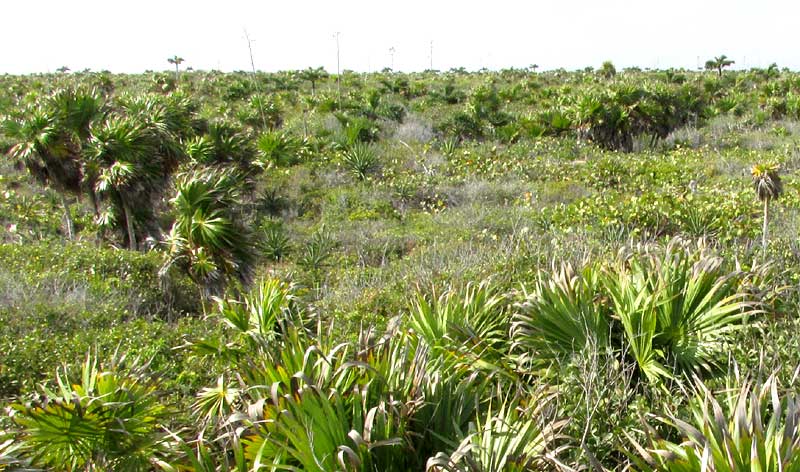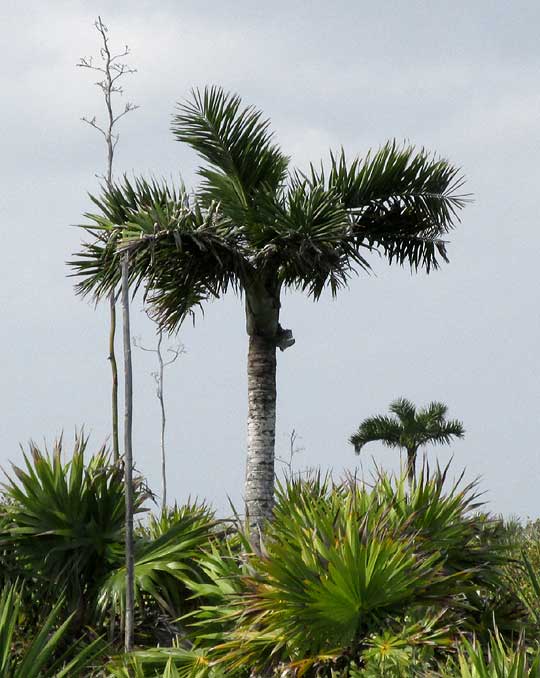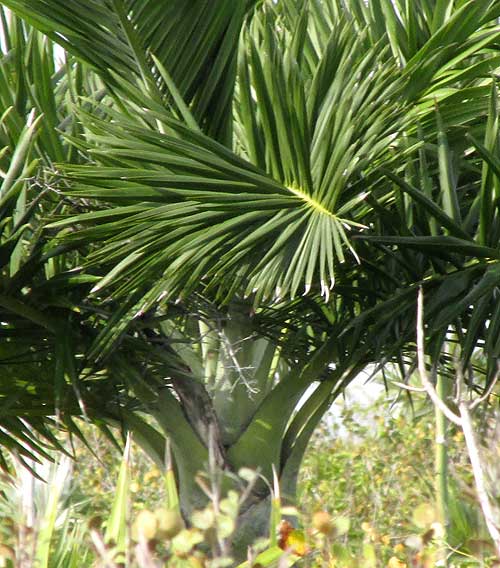Excerpts from Jim Conrad's
Naturalist Newsletter

from the January 18, 2015 Newsletter issued from Río Lagartos, on the Yucatan Peninsula's northern coast (~N21.60°, ~W88.16°), Yucatán state, MÉXICO
BUCCANEER PALM
Along the coast not far from Río Lagartos, if you climb atop a certain sand dune maybe a hundred feet (30m) inland and look inland, you'll see a wild, windswept, sun drenched flatland mantled with scrubby, low vegetation largely not over waist high, but here and there with palms of various sorts rising above everything. You can see such a view above.
In that view the low palms in the foreground are Chit Palms, Thrinax radiata; the large-leafed plants forming a low thicket at the picture's center-right are Sea-grapes, Coccoloba uvifera; tall, very slender spikes rising above everything here and there are flowering stems of Caribbean Agaves, Agave angustifolia, and; on the horizon you can see widely scattered palms looking like upside-down feather dusters.
The feather dusters are Buccaneer Palms, sometimes also called Cherry Palms or Sargent's Cherry Palms. They're PSEUDOPHOENIX SARGENTII, and stand maybe 15 feet tall (4.5m). A closer look at a Buccaneer Palm rising from an impenetrable thicket of Chit palms and Caribbean Agaves is seen below:

You can see that Buccaneer Palms are very handsome and worthy of being planted. A lot of people have thought that for a long time, and that's the prime reason, along with habitat destruction, that so few remain in the wild. Throughout their distribution from the Yucatan's northern and eastern coasts, Cuba, southern Florida, the Bahamas and Hispaniola, the species has been dug up and hacked down for so long that nowadays a view of them such as ours is hard to find.
However, so many of their numbers have made it into the gardening business that in warmer areas they're easy to buy. At a gardening forum on the Internet, "billowen" in Port Charlotte, FL writes, "I planted a six footer a little over a year ago, I got a good deal for $200.00. This tree could easily retail for $500.00."
And that's why I'm vague about the location of the individuals in my pictures.
Another picture, showing that the fronds are feather-like, not fan-like, and that the frond segments, or pinnae, arise from the midrib, or rachis projecting upward V-like, not downward, is shown below:

In that picture, below the fronds and in the picture's center, you can see a small, whitish, stalked, fruiting cluster from which the fruits have fallen. The configurations of the flower clusters and pinnae are important field marks, though in our area the palm's general form and habitat are so distinctive that you don't need to look closely to know you have a Buccaneer Palm.
In Florida they're trying to reintroduce Buccaneer Palms. Earlier, in one of their prime locations, "... the interior of Elliott Key was bulldozed by spiteful developers just prior to federal purchase of the island for the formation of Biscayne National Park." Wikipedia provides more information on its Pseudophoenix sargentii page.